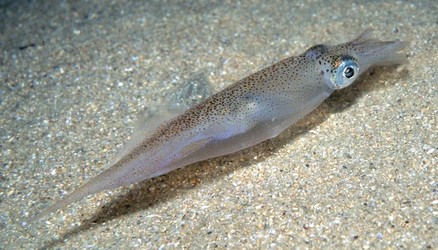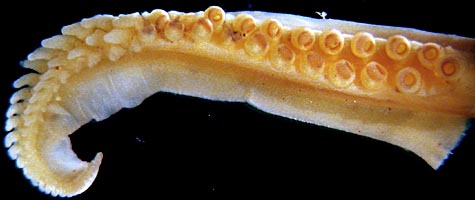Alloteuthis
Michael Vecchione and Richard E. YoungImage: Photograph by Peter Wirtz
Alloteuthis contains three species.



This tree diagram shows the relationships between several groups of organisms.
The root of the current tree connects the organisms featured in this tree to their containing group and the rest of the Tree of Life. The basal branching point in the tree represents the ancestor of the other groups in the tree. This ancestor diversified over time into several descendent subgroups, which are represented as internal nodes and terminal taxa to the right.

You can click on the root to travel down the Tree of Life all the way to the root of all Life, and you can click on the names of descendent subgroups to travel up the Tree of Life all the way to individual species.
For more information on ToL tree formatting, please see Interpreting the Tree or Classification. To learn more about phylogenetic trees, please visit our Phylogenetic Biology pages.
close boxIntroduction
Small loliginids of the eastern Atlantic.
Brief diagnosis:
A loliginid ...
- with posterior mantle elongated as a tail-like structure; fins longer than broad.
- with a small conus sometimes apparent on gladius.
- with an Eastern Atlantic distribution
Characteristics
- Arms
- Hectocotylus:
- Ventral crest absent.
- Proximal suckers unmodified.
- Proximal region with 10 - 12 (usually 11) normal suckers in ventral series followed distally by papillae.
- Tentacles
- a Tentacular clubs expanded, suckers in four series; two medial manal series with larger suckers.
- Head
- Buccal supports without suckers.
- Mantle
- Mantle long, relatively narrow; posterior end drawn out into narrow, pointed tail, up to 6 cm in adults.
- Fins
- Fins reach posterior tip of mantle.
- Fins heart-shaped, lateral angles rounded, posterior borders concave, extending posteriorly along tail.
- Photophores
- Photophores absent.
- Viscera
- Eggs small.
- Spermatophore with small cement gland.


Figure. Ventral view of A. subulata showing dimorphism in the relative sizes and shapes of mature males. Top - Small male which we presume to be a sneaker male (sneakers are known in L. reynauldii - Hanlon, et al., 2002). Bottom - Large male with elongate tail. Females are approximately the same size and shape as the small male. Drawings from Naef (1921-3).
Comments:
Alloteuthis is morphologically very similar to Loligo and was considered by Vecchione et al. (1998) to be a subgenus. However, molecular analyses by Anderson (2000) indicate that Alloteuthis should be a separate genus. This supports earlier inferences by Naef (1921-23) and Alexeyev (1989) that the presence of a gladial conus in Alloteuthis should be considered a generic character. The conus in Alloteuthis would clearly separate the genera but it can be very difficult to find and in some Alloteuthis specimens may be reduced until it is essentially absent. The posterior tip of the mantle in Alloteuthis is elongate into a tail-like structure that tends to be more pointed than in Loligo. This is particularly true for males but identification of this character state can be subjective in females.
References
Anderson, F.E. 2000. Phylogeny and historical biogeography of the loliginid squids (Mollusca: Cephalopoda) based on mitochondrial DNA sequence data. Molecular Phylogenetics and Evolution 15: 191-214.
Alexeyev, D.O. 1989. Advantages and limitations of using the gladius in diagnosis of species and genera of the family Loliginidae (Cephalopoda). Zoologichesky Zhurnal, 68(6):36-42.
Naef, A. 1921-1923. Die Cephalopoden. Fauna e Flora del Golfo di Napoli, Monographie 35, Vol I, Parts I and II, Systematik, pp 1-863.
Vecchione, M., T. F. Brakoniecki, Y. Natsukari and R. T. Hanlon. 1998. A provisional generic classification of the family Loliginidae. Smithson. Contr. Zool., 586.
Vecchione, M., E. Shea, S. Bussarawit, F. Anderson, D. Alexeyev, C.-C. Lu, T. Okutani, M. Roeleveld, C. Chotiyaputta, C. Roper, E. Jorgensen and N. Sukramongkol. 2005. Systematics of Indo-West Pacific loliginids. Phuket Mar. Biol. Cent. Res. Bull. 66: 23-26.
Title Illustrations

| Scientific Name | Alloteuthis subulata |
|---|---|
| Location | Off Cascais, Portugal |
| Specimen Condition | Live Specimen |
| Identified By | Peter Wirtz |
| View | Dorsal-oblique |
| Copyright |
© 2007 Peter Wirtz

|
About This Page
Michael Vecchione

National Museum of Natural History, Washington, D. C. , USA
Richard E. Young

University of Hawaii, Honolulu, HI, USA
Correspondence regarding this page should be directed to Michael Vecchione at
vecchioneM@si.edu
Page copyright © 2018
 Page: Tree of Life
Alloteuthis .
Authored by
Michael Vecchione and Richard E. Young.
The TEXT of this page is licensed under the
Creative Commons Attribution-NonCommercial License - Version 3.0. Note that images and other media
featured on this page are each governed by their own license, and they may or may not be available
for reuse. Click on an image or a media link to access the media data window, which provides the
relevant licensing information. For the general terms and conditions of ToL material reuse and
redistribution, please see the Tree of Life Copyright
Policies.
Page: Tree of Life
Alloteuthis .
Authored by
Michael Vecchione and Richard E. Young.
The TEXT of this page is licensed under the
Creative Commons Attribution-NonCommercial License - Version 3.0. Note that images and other media
featured on this page are each governed by their own license, and they may or may not be available
for reuse. Click on an image or a media link to access the media data window, which provides the
relevant licensing information. For the general terms and conditions of ToL material reuse and
redistribution, please see the Tree of Life Copyright
Policies.
- First online 25 January 2006
- Content changed 02 September 2010
Citing this page:
Vecchione, Michael and Richard E. Young. 2010. Alloteuthis . Version 02 September 2010 (under construction). http://tolweb.org/Alloteuthis/23876/2010.09.02 in The Tree of Life Web Project, http://tolweb.org/








 Go to quick links
Go to quick search
Go to navigation for this section of the ToL site
Go to detailed links for the ToL site
Go to quick links
Go to quick search
Go to navigation for this section of the ToL site
Go to detailed links for the ToL site